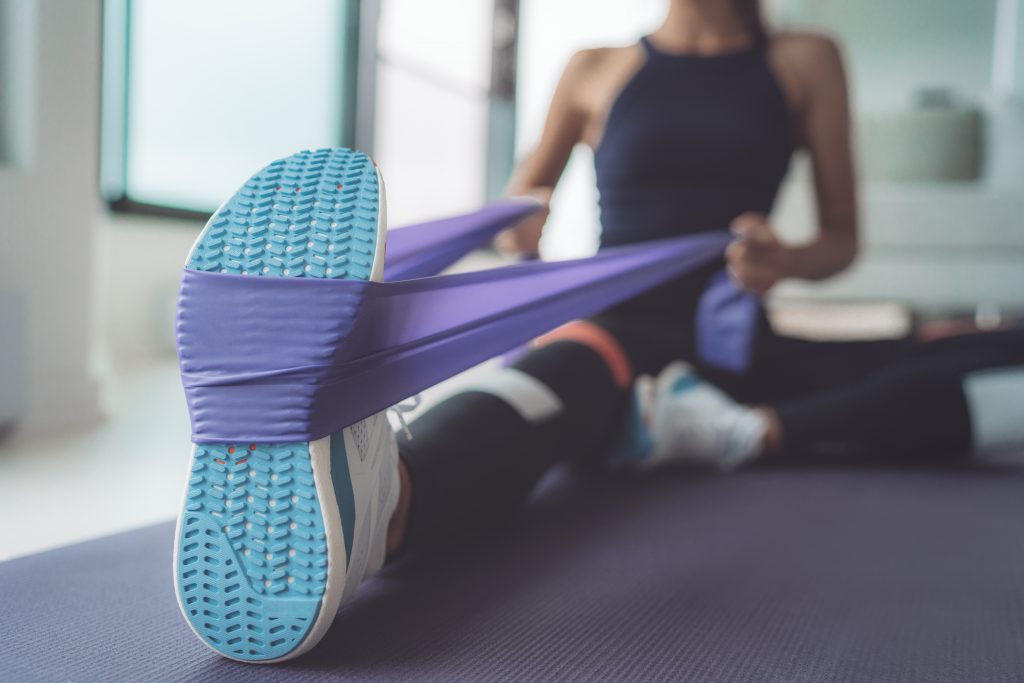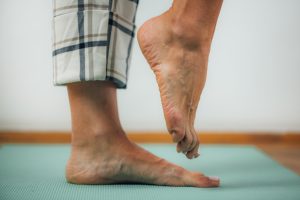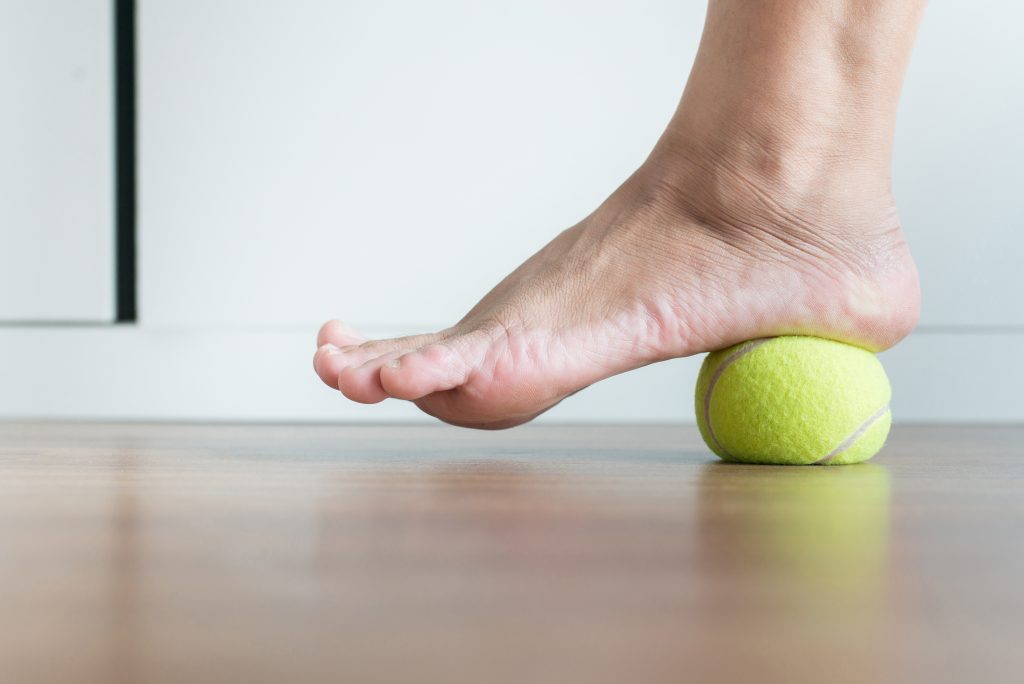What is plantar fasciitis?
Plantar fasciitis, or plantar fasciitis, is an inflammation of the foot, in the plantar fascia. The plantar fascia is a fibrous ligament attached to the heel bone that extends to the base of the toes.
What are the causes of plantar fasciitis?
This bottom of foot pain can be caused by repetitive movements that, over time, cause the fascia to stretch and micro-tear. Rest assured, this condition is not fatal, and there are treatments and exercises to relieve it. Physiotherapy sessions, cortisone injections, foot orthoses, exercises and stretching are some of the options. In this article, we give you 3 exercises to do at home, in order to relieve plantar fasciitis, and regain your mobility.
1) Foot massage to relieve plantar fasciitis
Foot massage is one of the easiest exercises to relieve plantar fasciitis. In particular, it helps the membrane of your foot to relax and unwind gently. For example, get a foot massage ball, a tennis ball, a foam roller or a cold can and place it on the floor. You sit in a chair and then put your foot on the ball or object and roll it back and forth. Repeat this movement for a few minutes, always applying light pressure.
Ideally, you should do this exercise 3 times a day. Be careful not to force yourself if you are already prone to pain. Similarly, if you find that massaging with an object hurts you, you can use your hands. In this way, you exert a measured and controlled pressure. Don’t hesitate to make an appointment with your podiatrist to see together which plantar fasciitis treatment or exercises to choose according to the level of tear.

2) Plantar fasciitis stretches to relax the tissues and gain mobility
Stretching your foot and calf is a great way to relax your arch. In general, it is recommended to do the foot and Achilles tendon-triceps sural complex stretches, which provide relief for about 2 to 4 months. As people suffer from this disorder usually in the morning when they get up, it is advisable to perform these exercises just before standing. To do this, you can either buy an elastic band (easily found in sports shops or orthopaedic pharmacies), a bath towel, or do the stretches with your hands. If you choose an elastic band, here is the exercise you can do:
- sit on the floor with your back straight and stretch your legs;
- pass the elastic or towel over the arch of your foot, and hold the other end in your hands;
- Stretch and hold your foot straight, and hold for about 30 seconds;
- Repeat this exercise 3 times.
Similarly, you can use a wall to stretch your fascia and calf muscles, like this:
- place the plantar side of your forefoot against the wall, so that your toes are in contact with it, and the heel on the ground;
- Move your leg forward so that you feel a tolerable stretch in the arch of your foot;
- hold the position for about 15 seconds, then release.

3) Practice balancing on one leg to improve foot mobility
Working the stabilizing muscles of the foot ensures good mobility and better strengthening of the plantar tissues. There is a simple exercise you can do at home. In a standing position, place a pillow under your foot and balance on one leg. The challenge is to hold this position for as long as possible, while controlling your movements to remain stable. Do this exercise for about 30 seconds on each leg, and repeat it 2 to 3 times during the day. You will gain stability, while naturally strengthening your tissues and tendons.
Other plantar fasciitis treatments if pain persists
Even with plantar re-education exercises to be done at home, the symptoms may persist. There are then other more advanced treatments.
Physiotherapy
The physiotherapist proceeds to reduce the inflammation, notably with the use of electrotherapy (such as ultrasound or TENS machine), and ice. In addition, he explains the different positions and movements in which plantar fasciitis can worsen, and which should therefore be avoided. Next, the practitioner uses manual therapy techniques, such as the exercises outlined above. The main focus is on helping the muscles to relax, through flexibility and muscle strengthening exercises for the calf muscles and the intrinsic muscles of the foot.
Wearing a foot orthosis
Plantar fasciitis can be treated by wearing an orthosis specially designed for this condition. At EVO Laboratories, this is our specialty, so you are in good hands! In order to design the best orthosis for your needs, we perform a complete biomechanical evaluation, divided into 3 steps. First, our orthotists look at your posture, your gait and the condition of your feet and ankles. Once these observations have been made and the data collected, we take an impression of your feet. Perfectly molded to the shape of your feet, and custom-made according to your morphology, the pair of orthopedic insoles will correct the condition of your feet, and relieve your plantar fasciitis. It is thanks to the addition of corrective elements, in particular at the level of the heel, that the sole will allow to absorb the shocks at the level of the heel to better protect it. You will therefore be back on your feet in no time. In general, an adaptation period of 4 weeks will be necessary, then we will invite you to come back and see us in clinic, in order to make sure of your comfort and, if necessary, to redo the adjustments.
Cortisone injection
How do you cure plantar fasciitis when exercises and stretching still don’t work? Again, there are more robust solutions, such as cortisone injections. Cortisone is a derivative of cortisol (a hormone secreted by the adrenal glands, at the level of the kidneys), which has formidable anti-inflammatory properties. Cortisone infiltration is therefore recommended when plantar fasciitis or Lenoir’s thorn is too strong (besides, the second is often a long-term consequence of the first). By performing injections, you will be able to localize more precisely the area in question, treat the pain more quickly, and reduce your recovery time. To ensure the success of your injections, there are a few things you should do:
- Extend your recovery time between exercise sessions;
- Warm up and stretch well before and after a sport activity;
- renew your running shoes regularly;
- Return to your training slowly and progressively, without forcing yourself.
However, before considering injections, make an appointment with a specialist, who can advise you on the right treatment for your situation.
Healing time for plantar fasciitis
Depending on the methods used to relieve your pain, plantar fasciitis can take anywhere from 3 to 6 months to completely disappear. In some cases, it can take up to 12 months.
Things to remember
- Plantar fasciitis can be relieved by simple stretching and relaxation exercises, which can be done at home without much equipment;
- If these exercises don’t work, consider braces, physical therapy or cortisone injections;
- Do not hesitate to consult a general practitioner, or to make an appointment with a podiatrist in order to make a complete diagnosis and find the appropriate treatment.
Share this article
Related posts
July 20 2021
How to identify poor blood circulation?
June 15 2021


